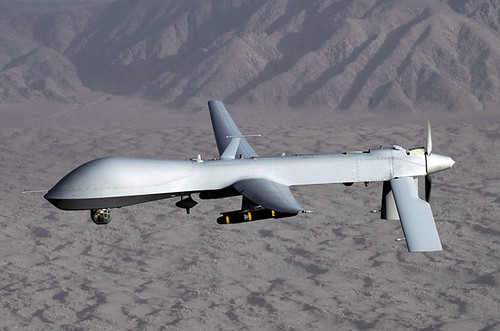
Central Intelligence Agency (CIA) unmaned drones have killed untoll numbers of civilians in Pakistan. The United States imperialists have stepped-up their agressive assaults on the people of central and south Asia in the quest to conquer Afghanistan., a photo by Pan-African News Wire File Photos on Flickr.
U.S. ramps up killer drone squadrons over Yemen and Somalia
Officials insist new technology is more precise, minimizing the risk of 'collateral damage'
By Jonathan Manthorpe, Vancouver September 23, 2011
The United States administration of President Barack Obama is dramatically extending the reach of its program using missile-armed remote-controlled drone aircraft to assassinate terrorist and militant group leaders.
The focus of the operation to hunt down and kill senior figures in al-Qaida and linked groups is shifting from Pakistan, where 581 of the more than 600 people killed in the 118 drone strikes launched last year were hiding, to the Horn of Africa and the Arabian Peninsula.
The movement to deploy the Predator and Reaper drones to a U.S. base in Djibouti in the Horn of Africa, Ethiopia, an un-named Arab state, and the Indian Ocean islands nation of Seychelles is in response to the rising presence of al-Qaida and its affiliates in the failed states of Somalia and Yemen.
Since he came to the presidency in 2008, Obama and his officials have increasingly adopted the controversial drone program as their weapon-of-choice against leaders of militant groups.
The New American Foundation keeps track of drone attacks. It reckons there were 33 in 2008 when Obama came to office, compared with nearly 120 last year.
The program is controversial not least because of the hazy legal authority under which U.S. officials, usually Central Intelligence Agency operatives sitting at consoles in America, remotely control the drones and fire their Hellfire missiles at people intelligence information identifies as militants in Pakistan or elsewhere.
The drones were originally designed as aerial reconnaissance vehicles, but since they have been equipped with missiles they are known to have been used in Afghanistan, Libya, Yemen, Iraq and Somalia as well as Pakistan.
As well as the cloudy legal authority for assassinating people in countries with which the U.S. is not at war, there is the matter of killing innocent bystanders.
In Pakistan in particular, there has been much public outrage at so-called "collateral damage" when missile attacks have killed women, children and other people who just happened to be in the wrong place at the wrong time. U.S. officials insist the drones have become much more of a precision killing instrument, or "operational tool" as they prefer to call them, since the early days.
The New American Foundation says it believes that, since April, drone attacks in Pakistan's lawless border area with Afghanistan have killed up to 191 militants and only 10 civilians.
Even so, the U.S. is reported by the Washington Post and other news media to have in April suspended drone flights from an air strip in Pakistan's southwestern Baluchistan province amid tensions with the Islamabad government.
Those tensions stem from flagrant and unsubtle operations by American intelligence agents in Pakistan, and have persisted because of the mutual suspicion between Washington and Islamabad after U.S. commandos killed Osama bin Laden at his hideout in the Pakistani military enclave of Abbottabad in May.
Since April, the drone-fired attacks in Pakistan have all been launched from Afghanistan.
It is the success of this assassination program, in contrast to the George W. Bush administration's use of U.S. and allied military units against terrorists, that has precipitated the move to the Horn of Africa and the Arabian Peninsula.
Yemen, the family home of bin Laden where President Ali Abdullah Saleh is besieged by four separate uprisings, and Somalia, where there has been no functioning government for 20 years, are both the kind of failed states that provide a refuge for al-Qaida.
Yemen has become a blatant terrorist hideout with the establishment of al-Qaida in the Arabian Peninsula. Among this group is the man some American officials regard as the most dangerous al-Qaida member at large, the charismatic Americanborn cleric and online preacher, Anwar al-Aulaqi.
Aulaqi fled to his family home in Yemen from the U.S. after the Federal Bureau of Investigation linked him to the Sept. 11, 2001, hijackers; since then, he has inspired several attempted attacks in America - and one successful attack at Fort Hood, Texas.
He escaped a drone attack in Yemen in May, but remains at the top of the CIA's target list.
Aulaqi is also linked to the Islamic militant al-Shabab group in Somalia, which controls much of the south of the country where there has been no functioning government since 1991.
U.S. forces have made several conventional air strikes against al-Shabab leaders and units in the last few years, but in June used missile-armed drones for what is believed to be the first time to try to kill two senior members of the group near the southern city of Kismayo.
U.S. embassy documents published by WikiLeaks show that in 2009 American officials got permission from Seychelles President James Michel to use his country as a base for unarmed drones to gather information on Somali pirates and militants. Michel said that because of political sensitivities he and he alone is to be informed if armed drones are being used.
In Ethiopia, the government of Prime Minister Meles Zenawi is being equally cautious before playing host to Obama's killer drones.
jmanthorpe@vancouversun.com
No comments:
Post a Comment